
KFC and I really enjoyed teaching Model UN in the Middle East this past September.
Over the past two weeks, KFC and I have been teaching Model UN in the Middle East, including Qatar, Jordan, Dubai, Kuwait, and Bahrain. It has been an incredible opportunity to not only learn more about Model UN in the region, but also to meet some of the most passionate and dedicated MUN teachers and educators I’ve ever met. And these past two weeks showed us the potential for Model UN here — not just in terms of the growing number of students and schools who participate — but in terms of the potential impact this activity can have on the lives of students and their communities.
The biggest event of our teaching tour was the inaugural Qatar Leadership Conference, which took place in Education City, Doha, from September 20-22. Over 400 high school students and teachers attended the conference, which featured a series of presentations by leading educators in Model UN, film, and international education. The conference was featured in several regional publications, including the Gulf Times.
KFC and I were asked to give 10 different presentations at the conference on MUN-related topics. One of KFC’s workshops was “What the UN Wants for Model UN,” in which he shared his takeaways from the UN’s Model UN Workshop in August. One of my workshops was “What Should Model UN Teach?” in which I described the vast spectrum of differences between Model UN programs around the world. KFC also led a workshop on negotiation skills, and I gave advice to high school seniors and juniors on how to share their Model UN experience on university applications.
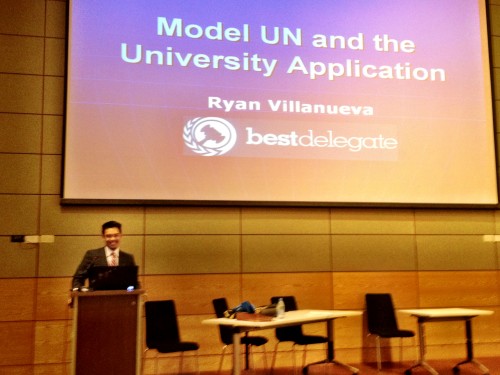
I gave a presentation on “Model UN and the University Application” at the inaugural Qatar Leadership Conference.
In addition the conference, KFC and I visited different schools around the region, including the American Community School in Jordan, the Amman Baccalaureate School, Dubai International Academy, the Universal American School in Kuwait, and the Ibn Khuldoon National School in Bahrain.
We worked with students on fundamental Model UN skills, such as public speaking and resolution writing. We also provided professional development for teachers, helping them learn the ins and outs of Model UN, how the activity differs across regions, and what steps they can take to build up their Model UN programs.
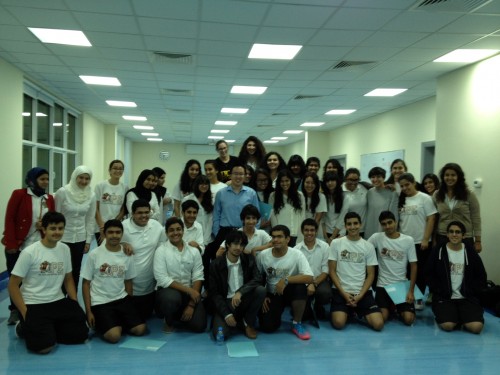
KFC with students and teachers at his Model UN workshop in Bahrain.
We met many students, teachers, and educators who believe that Model UN in the Middle East is important because it can inspire positive change in a part of the world that has seen so much chaos. I wanted to explore this, and in my workshops, I asked students and teachers to write resolutions in response to recent events surrounding the “Innocence of Muslims” video.
It was an engaging topic that hit close to home and sparked meaningful discussion. Using Model UN to explore this issue prompted students and teachers to look at the topic from different perspectives, including those opposite their own. They produced draft resolutions that sought to strike a balance between protecting the freedom of speech and protecting religious diversity, while also providing physical protection for foreign nationals. This turned out to be a powerful exercise that showed the potential for using Model UN to engage youth by providing a structured and thoughtful way to explore political and social issues.

I met many students and teachers who believe in the power of Model UN to inspire positive change.
Through our experiences at the Qatar Leadership Conference and teaching Model UN at schools around the region, KFC and I learned a lot about Model UN in the Middle East and how much it has grown in recent years. We met many students and teachers who are passionate about the activity and its potential for inspiring change, and we joined many discussions on how to help Model UN keep growing.
KFC and I would like to share those discussions below, and also offer our suggestions for seven steps that students and teachers can take to build successful Model UN programs in the Middle East. We also believe these lessons apply to other regions in the United States and around the world.
1. Organize 1-day MUN conferences.
The key to building Model UN in the Middle East is creating more opportunities for students and teachers to participate in Model UN, and the best way to do this is the creation of 1-day MUN conferences throughout the region.
The purpose of a 1-day conference is to introduce new delegates to Model UN. The conference also gives experienced delegates, student officers, and secretariat an opportunity to practice MUN skills, chairing, and conference organizing on a smaller scale and in a much more controlled and relaxed setting than a typical multi-day conference.
A 1-day-long conference can be held on a weekend, on campus, and in classrooms. This means that delegates and directors don’t miss school, don’t have to travel far, and don’t have to pay a lot to attend. Everyone comes in the morning, leaves in the afternoon, and gets home in time for dinner.
Each committee (also called a “forum” at THIMUN conferences) should have a limited number of delegates and topics, like 30 delegates or less, and only 1 topic. A smaller forum is easier to manage and gives every delegate a chance to speak. If necessary, you can have duplicate forums. I used to attend training conferences in Southern California where every forum was the Security Council.
Delegates should still wear business attire, but the 1-day conference can be less formal and have shortened opening and closing ceremonies. Some 1-day conferences skip the opening ceremony altogether. After registration, delegates go straight to committee.
Here’s a sample schedule for a 1-day training conference:
- 8am – 9am: Registration, delegates go straight to committee (Skip Opening Ceremonies)
- 9am – 10am: Icebreakers and Opening Speeches
- 10am – Noon: Lobbying and Resolution Writing
- Noon – 1pm: Lunch for Delegates and Approval Panel for Directors
- 1pm – 4pm: Debating and Voting
- 4pm – 5pm: Closing Ceremonies
One of the best examples to look at is SOCOMUN, the largest 1-day MUN training conference in the world that took place last weekend.
2. Create circuits of local MUN conferences.
A 1-day conference is ideal for a group of neighboring schools. Each school can organize their own conference annually. As long as the conferences are scheduled some time apart from one another, each school in the group can attend each other’s conference. This could mean 1 conference taking place every month. When neighboring schools take turns hosting Model UN conferences for one another, this is called a “circuit.”
A circuit of conferences gives students multiple opportunities to participate in Model UN throughout the year. They get to practice and deepen their skills, whether as delegates or student officers. This makes them better prepared when they travel to the big international conferences like THIMUN Hague.
A circuit doesn’t have to be all 1-day conferences. A circuit can also include a multi-day national conference that is more formal, like AMMUN in Jordan and DIAMUN in Dubai. And everyone’s circuit can include a big regional conference like THIMUN Qatar.
To create a circuit, schools first need to organize regular 1-day conferences. Then, a group of local directors need to communicate with one another and draw up a schedule. Directors should assign specific weekends to conferences and make sure they don’t overlap.
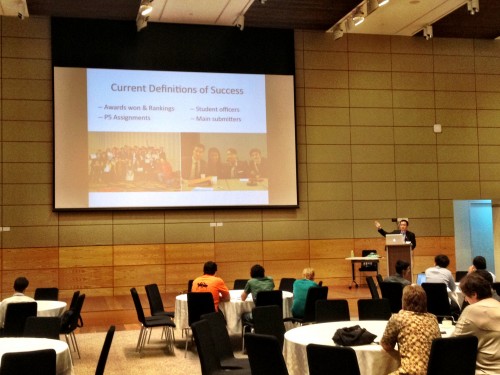
KFC presented a workshop on what makes a good Model UN program and how to define success.
3. Start Model UN outreach programs.
More and more schools in the Middle East and around the world are starting Model UN programs. Some are starting because the students want it; others because teachers are being asked to do it. In either case, new programs need help.
The purpose of an outreach program is to have experienced Model UN students visit neighboring schools to introduce them to Model UN and teach them how to participate. They can visit high schools with new MUN clubs that need help. They can also visit middle schools to get their students interested in Model UN and ready to join the club when they get to high school.
The goal of the outreach program is to have the new school attend a 1-day training conference. Conducting outreach also raises the level of debate at conferences. And it’s a great opportunity for students to demonstrate leadership in Model UN.
To start an outreach program, appoint a student officer in charge of outreach. Have them get in contact with one neighboring school, whether it’s a high school or middle school, to ask if they can talk about Model UN. As part of their presentation, the student officer should run a brief MUN simulation.
4. Invite parents and principals to watch Model UN.
At the workshops I taught, a frequently asked question from teachers was how to gain support from parents and principals who are unfamiliar with Model UN. This is important not just because parents and principals are in charge of funding MUN trips and programs, but they should be aware of how valuable the activity is to their students and to the school. If they actively support Model UN, it’s easier for students and teachers to expand their programs, recruit students, start conferences, and reach out to other schools.
Parents and principals need to see their students participating in Model UN before they understand it. Invite parents and principals to conferences and showcase events. The 1-day conferences are good opportunities for this. You can also hold end-of-year events and run a simulation just for parents to watch, or have students take turns giving speeches. Even better would be having parents and principals participate in their own Model UN simulation!

Teachers who attended my professional development workshop in Dubai discovered that you can learn Model UN in 30 minutes or less!
5. Develop a teacher network through THIMUN Qatar.
A key theme that came up during the Qatar Leadership Conference was the need to improve communication between MUN directors in the region and also worldwide. One way to do this is to leverage THIMUN Qatar as the hub for Model UN in the Middle East.
Director Cameron Janzen and Conference Manager Ann Rogers have made it their mandate to promote Model UN in the region. They are achieving this by organizing multiple conferences and programs throughout the year, such as the flagship THIMUN Qatar Conference, the Qatar Leadership Conference, the Film Festival, and various outreach programs. THIMUN Qatar’s various conferences should serve as networking and professional development event for the teachers in attendance.
Besides communicating at conferences, teachers should be communicating year-round via THIMUN Qatar. Established teachers should be coordinating efforts with Cameron and Ann, specifically regarding conference schedules, as well as sharing resources. And teachers who are new to Model UN should get plugged into the Middle East community and seek support from more experienced teachers by getting in touch with THIMUN Qatar.
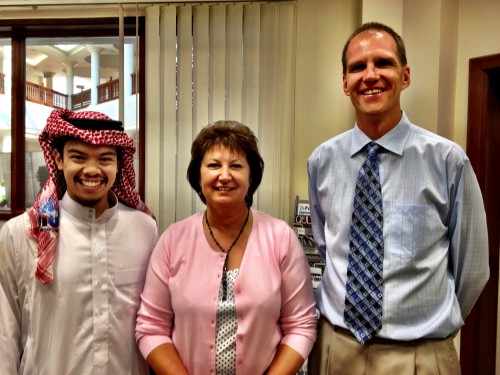
Me with Conference Manager Ann Rogers and Director Cameron Janzen of THIMUN Qatar
6. Explore the potential of Online MUN.
I had been aware that many students in the region are unable to travel to MUN conferences for socioeconomic reasons and lack of funding, but I was not aware that cultural and even political reasons were a concern, too. An MUN club from an all-girls school, for example, might be wary of or simply prohibited from attending conferences that don’t follow a specific dress code or where boys are present. Students might also encounter difficulties obtaining visas to enter foreign countries, or the political situation in their own country makes it difficult to travel.
A possible solution to these issues is the development of Online Model United Nations, which makes it possible for anyone, anywhere to do Model UN. O-MUN Director Lisa Martin, who also teaches MUN at the American Community School in Jordan, gave one of the keynote speeches at the Qatar Leadership Conference and showed a demo of O-MUN. Participation in O-MUN is free; all you need is a computer and an Internet connection. Students interact in a moderated environment, thanks to a technology stack centered around Blackboard Collaborate. We’ve profiled O-MUN on Best Delegate here.
O-MUN has huge potential not just for the Middle East but around the world. If you’re interested, visit their website and get in touch with Lisa. But if you’re really serious, check out the schedule for their online debates and sit in one yourself. Also, Lisa and the O-MUN team have recently started fundraising for a chance to demo O-MUN at THIMUN Hague, the largest Model UN conference in the world; check out their IndieGoGo page. (Disclosure: I donated on behalf of Best Delegate.)

Online MUN Director Lisa Martin gave one of the keynote speeches at the Qatar Leadership Conference.
7. Integrate Model UN into classroom curriculum.
The International Baccalaureate Organization is developing a new unit on Global Politics that will integrate Model UN into the curriculum. The IBO has started a pilot program at select schools, but when the unit gets rolled out, Model UN will probably grow exponentially. Many of the teachers I met were in IB and they were very interested in integrating Model UN into already existing curriculum.
If you are interested in integrating Model UN into your curriculum, even if you’re not in IB, I would highly recommended checking out the Overseas Family School Model UN program in Singapore. OFS Dean of International Relations David Taylor gave a presentation at the Qatar Leadership Conference on how Model UN perfectly complements IB’s educational goals, specifically the IB “learner profile.” He and his faculty have seamlessly integrated Model UN into existing classroom curriculum from high school to middle school and even primary school — they have 4th and 5th grade students doing Model UN!
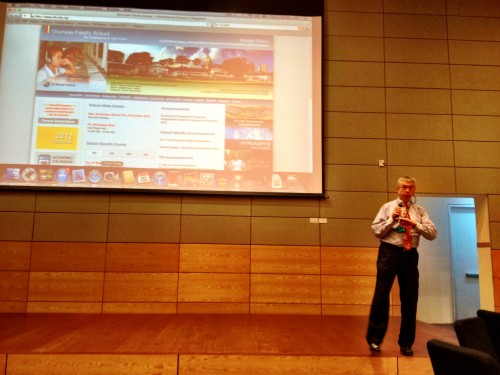
David Taylor gave a presentation on the Model UN program at the Overseas Family School in Singapore, which has students as young as the 4th and 5th grade doing Model UN!
KFC and I would like to give special thanks to Cameron Janzen and Ann Rogers of THIMUN Qatar, the students of Qatar Academy Model UN, and the Qatar Foundation for inviting us to the Qatar Leadership Conference and giving us this opportunity to teach Model UN in the Middle East.
We would also like to thank Lisa Martin at the American Community School in Jordan, Peter Carrigan at Amman Baccalaureate School, Tanusankar Chakraborty at Dubai International Academy, Richard Barbree and Valerie Wagner at the Universal American School in Kuwait, and Mohamad Ramadan and Jaime Fontenot at the Ibn Khuldoon National School in Bahrain for welcoming us into their schools, their homes, and their Model UN communities with such gracious hospitality.
KFC and I truly enjoyed teaching Model UN in the Middle East and we hope to visit again soon – inshallah!


